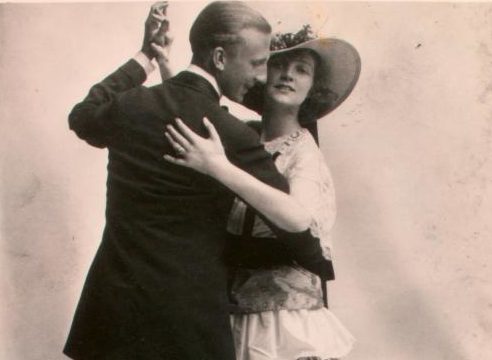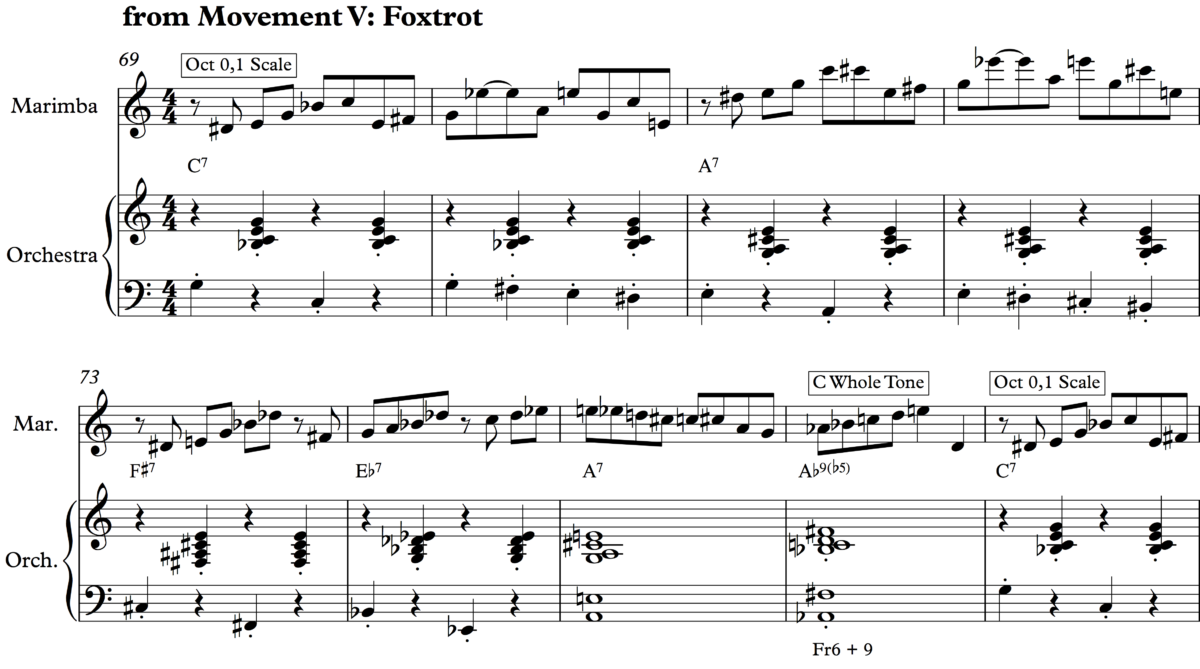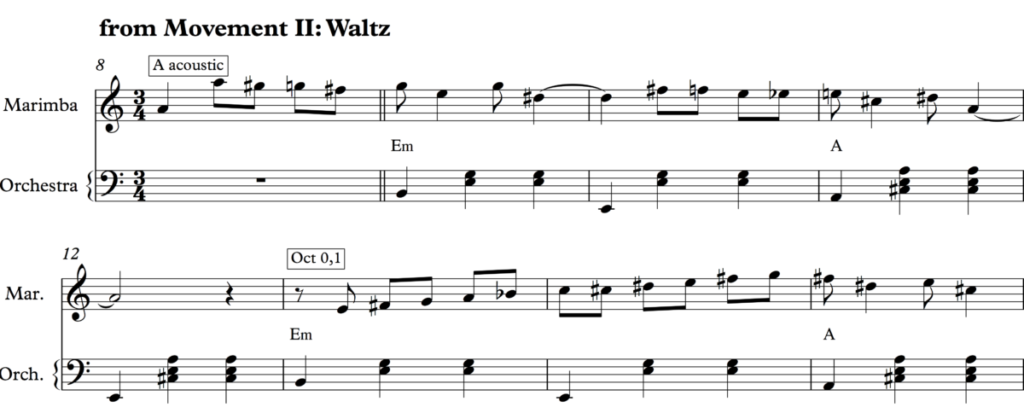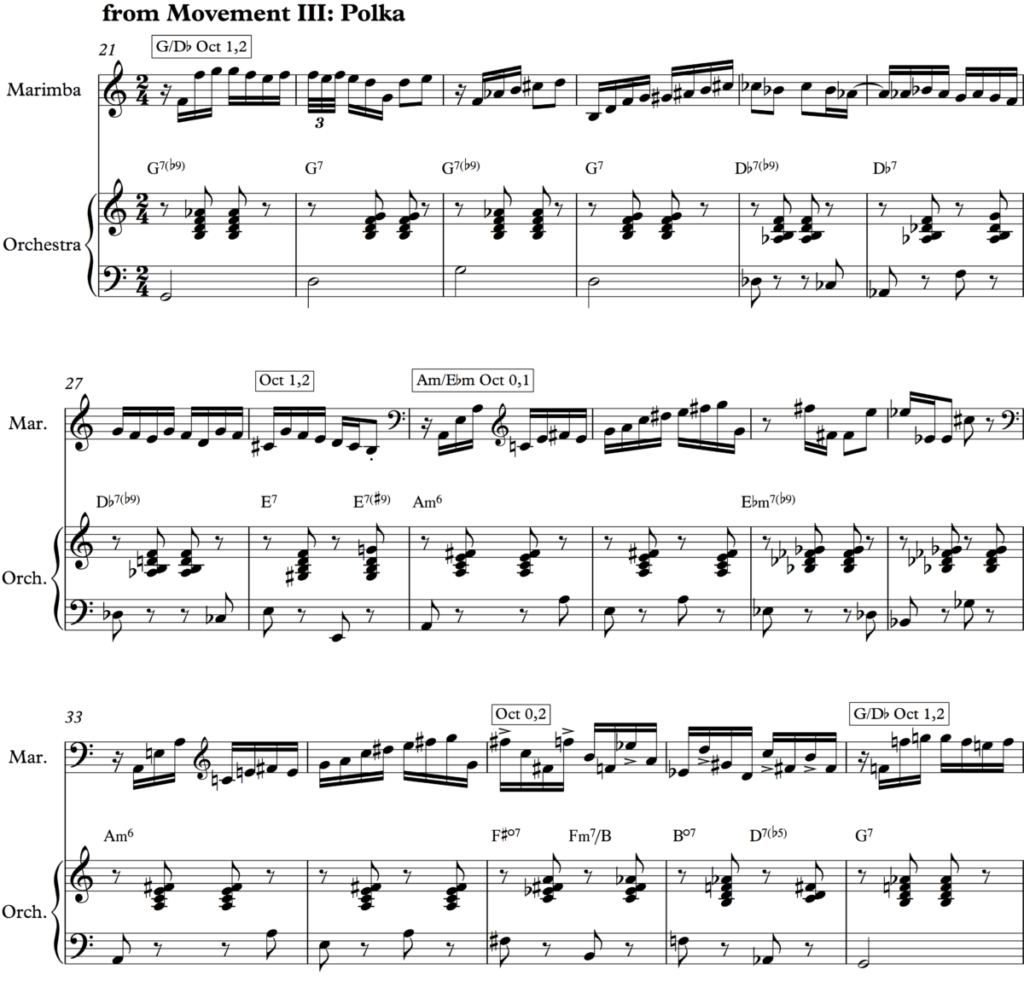
In between my semesters of teaching theory at our local community college, I put significant works towards completing a concertante called Ragtime Dances for Marimba and Orchestra. The piece is inspired by the American dance music of the ragtime era, specifically the works promoted by the Castle dance duo. Since my piece is for a community orchestra, it is strongly tonal, diatonic, and tertian in nature. There are areas of the piece which my theory class would be quite comfortable analyzing, and there are areas that make use of a variety of modes and synthetic scales. One element common to each of the five dances is the octatonic scale:

The above scale is known as the Octatonic [0,2], or Oct 0,2 for short. The octatonic is a mode of (very) limited transposition, and there are three possible scales: Oct 0,2; Oct 0,1; and Oct 1,2. The numbers of the names indicate all that is needed to identify a particular octatonic scale: two consecutive notes within the scale. 0 is C♮, 1 is C#, and 2 is D♮. Thus, Oct 0, 2 is the octatonic with the notes C and D in it.
Major and Minor Triads of the Octatonic
While my Russian Music Theory studies took me deep into octatonic territory, this exploration is focussed almost exclusively on the relationships of the major and minor harmonies within the scale. There are eight possible major and minor triads within an octatonic, each of which can be extended to a 7th or 9th chord:

The pattern of triads repeats at every 3 half-steps: the F root is a minor 3rd away from the D root, which is a minor 3rd from the B root, etc. Similarly, the F and B triads are a tritone apart, as are the A♭ and D triads.
A tritone relationship between triads is well familiar to the diatonic ear in a number of contexts. The most common in “classical” music is probably the Neapolitan 6th relationship to the dominant:

Sequence
The inherent symmetry of the octatonic makes it difficult to assert a perceived tonic within a tertian context. Ragtime Dances uses a few tricks to soften the impact of the octatonic to the unfamiliar ear and keep the listener’s ears tracking some sense of tonality. In the Foxtrot (Movement V), I utilize the harmonic sequence available at the minor 3rd:

While the familiarity of the ragtime um-pah-um-pah accompaniment gives the audience an easy hook, the octatonic scale lends itself to a couple other tricks:
- Each two-bar statement of the accompaniment figure is a “real transposition” of the sequence, in that the intervalic relationship is exact and not adjusted by the scale. The perceived tonality follows the sequence.
- The parallel major and minor chord pairs of the octatonic allows for a “blues note” figure. The marimba in bar 70 has both an E♭ leading to an E♮ over a C7 chord. Treating the octatonic this way fits within a well-established diatonic melodic pattern.
Scale Intersection
To reset the cycle, the A♭ and D in Bar 76 (above) offer some chromatic motion outside of the octatonic. The harmonic motion in bars 76 – 77 has many similarities to an augmented 6th chord (essentially a French 6th with an added major 9th) leading to a cadential 6-4, but the resulting effect sounds more authentic. Note that bar 76 confines itself to a C whole-tone scale, which shares 4 common tones with the Oct 0,1:

Other dance movements make use of the octatonic’s maximal intersection with the the melodic minor and its modes. Two scales are said to maximally intersect if there is only one note different within the smaller of the two collection of tones:

The octatonic run in the marimba fits quite nicely within this excerpt predominantly in A Acoustic:

Hexachords from the Triads
In the Polka I make use of a relationship between octatonics explored in the jazz sections of my piano concerto’s first movement (see pp. 43-49 of my thesis). Each pair of the following triads forms a collection of 6 pitch classes that does not intersect with the other collection. The two collections are complements, for there is no intersection and collectively they contain all 12 pitch classes.
 There is a curious harmonic relationship between these two hexachords: the ear appreciates the shift from one to the other as clear harmonic motion. There also is a symmetry between the two: one hexachord is comprised of Major triads a tritone apart, and the other of minor triads a tritone apart. Each hexachord can have harmonic motion with similar root movement yet different modes (major and minor). Each hexachord fits neatly within its own octatonic, and the two octatonics share only four notes.
There is a curious harmonic relationship between these two hexachords: the ear appreciates the shift from one to the other as clear harmonic motion. There also is a symmetry between the two: one hexachord is comprised of Major triads a tritone apart, and the other of minor triads a tritone apart. Each hexachord can have harmonic motion with similar root movement yet different modes (major and minor). Each hexachord fits neatly within its own octatonic, and the two octatonics share only four notes.
Major chunks of accompaniment within the Polka are based upon the hexachords alone, but the marimba uses other notes from the related octatonic to fill its line. Unlike my piano concerto, the polka uses dominant relationships (bars 28 and 36) to facilitate the transition between these complementary hexachords and their octatonics:

I am enjoying exploring the octatonic scale in this manner. It is an approach more direct than Rimsky-Korsakov’s use of the octatonic color or Stravinsky’s rich and varied modal approach. It also is a very different from the dark or glassy sections of my piano concerto found in movements 2 and 3. The excerpts above are a few of the ways I borrow ragtime elements and apply them to harmonies within the octatonic. These efforts result in a lighthearted sound suitable for a community orchestra and its audience.
Great blog article! I will be reading more of your entries. You are truly a great music theory blogger!
Thanks, Adriana!
Hello , I just discovered your blog – very illuminating and so clear, thank you. Patrick